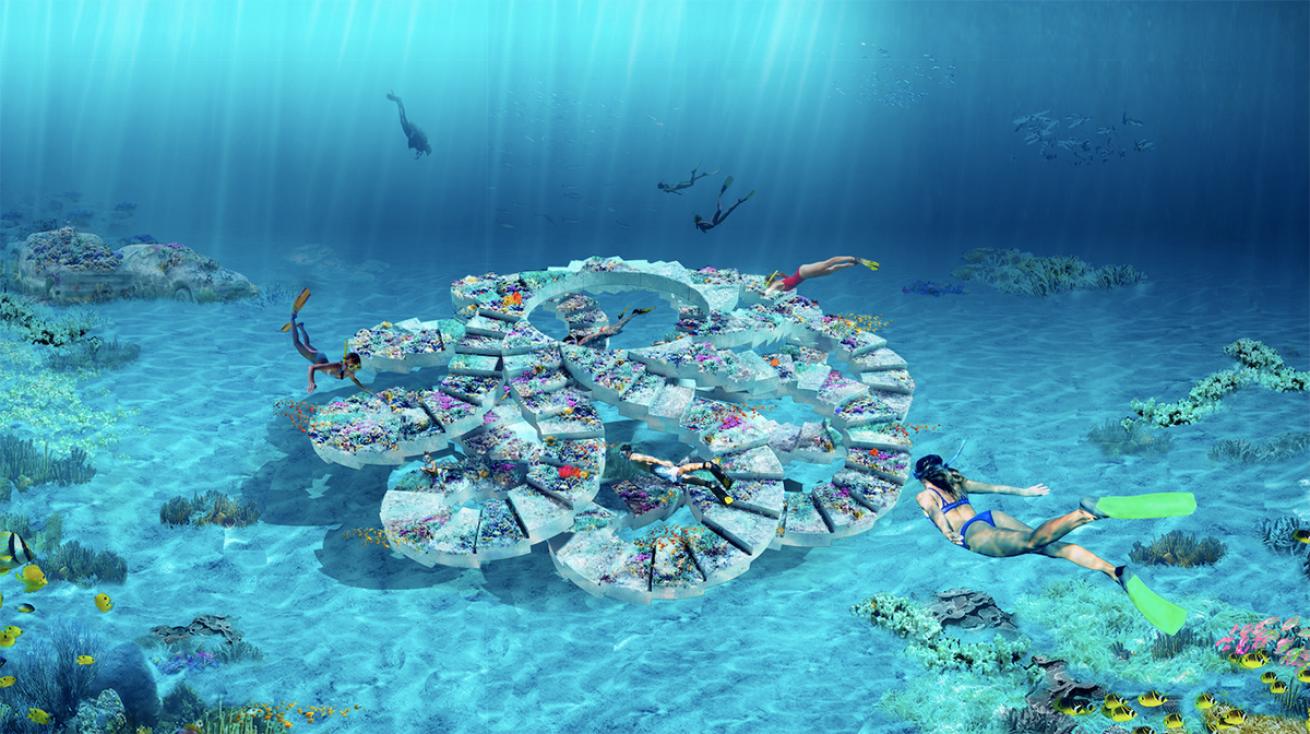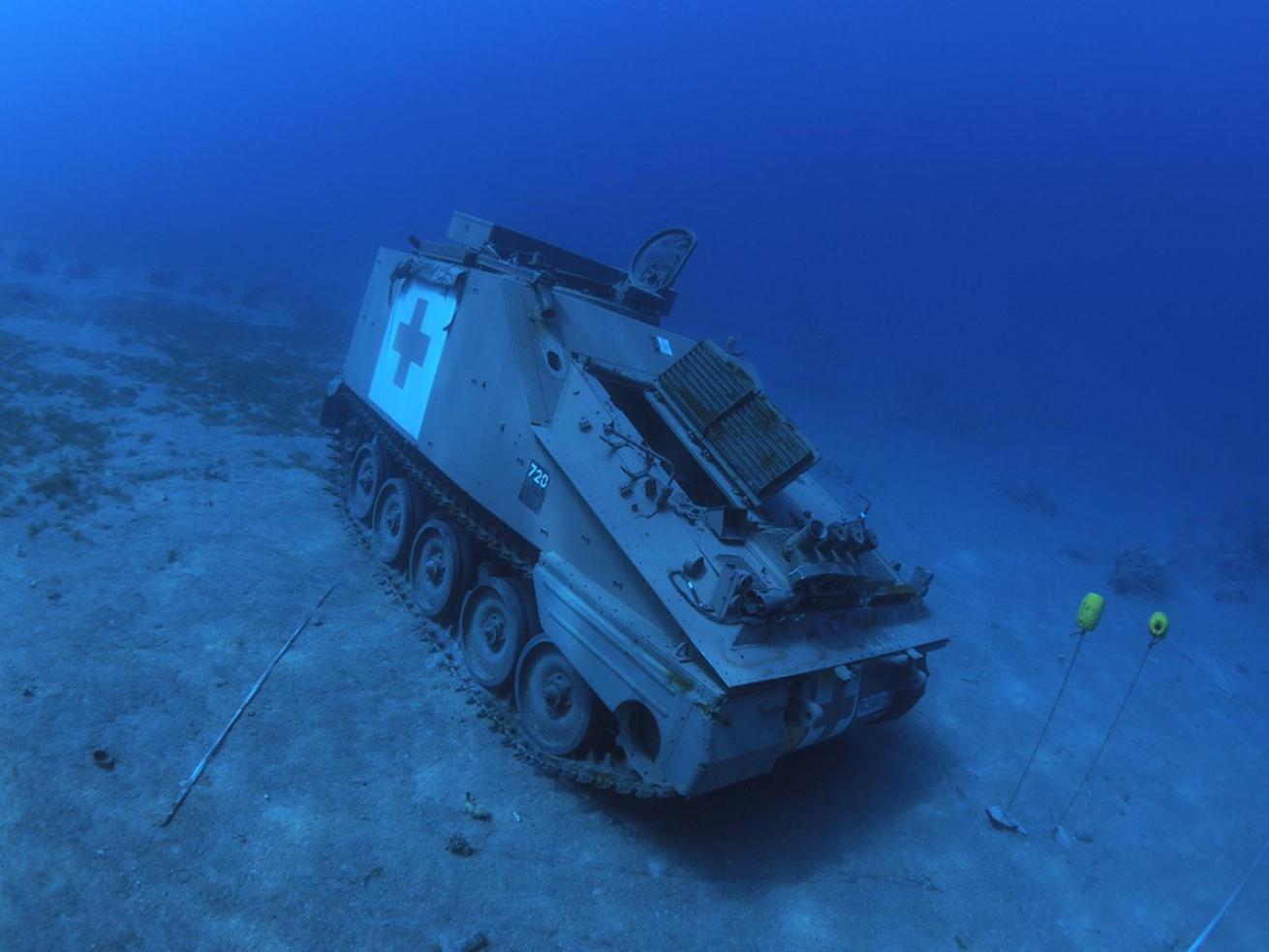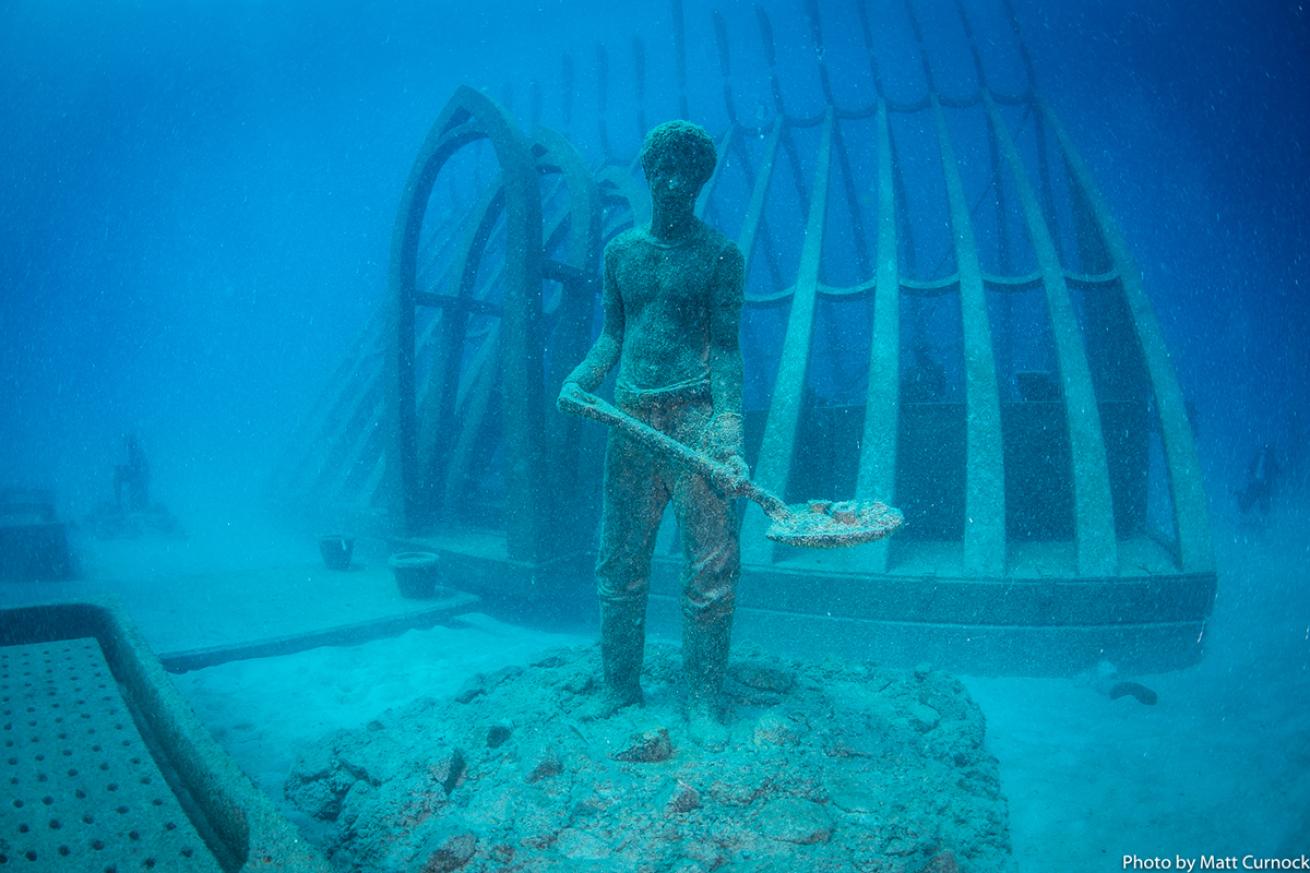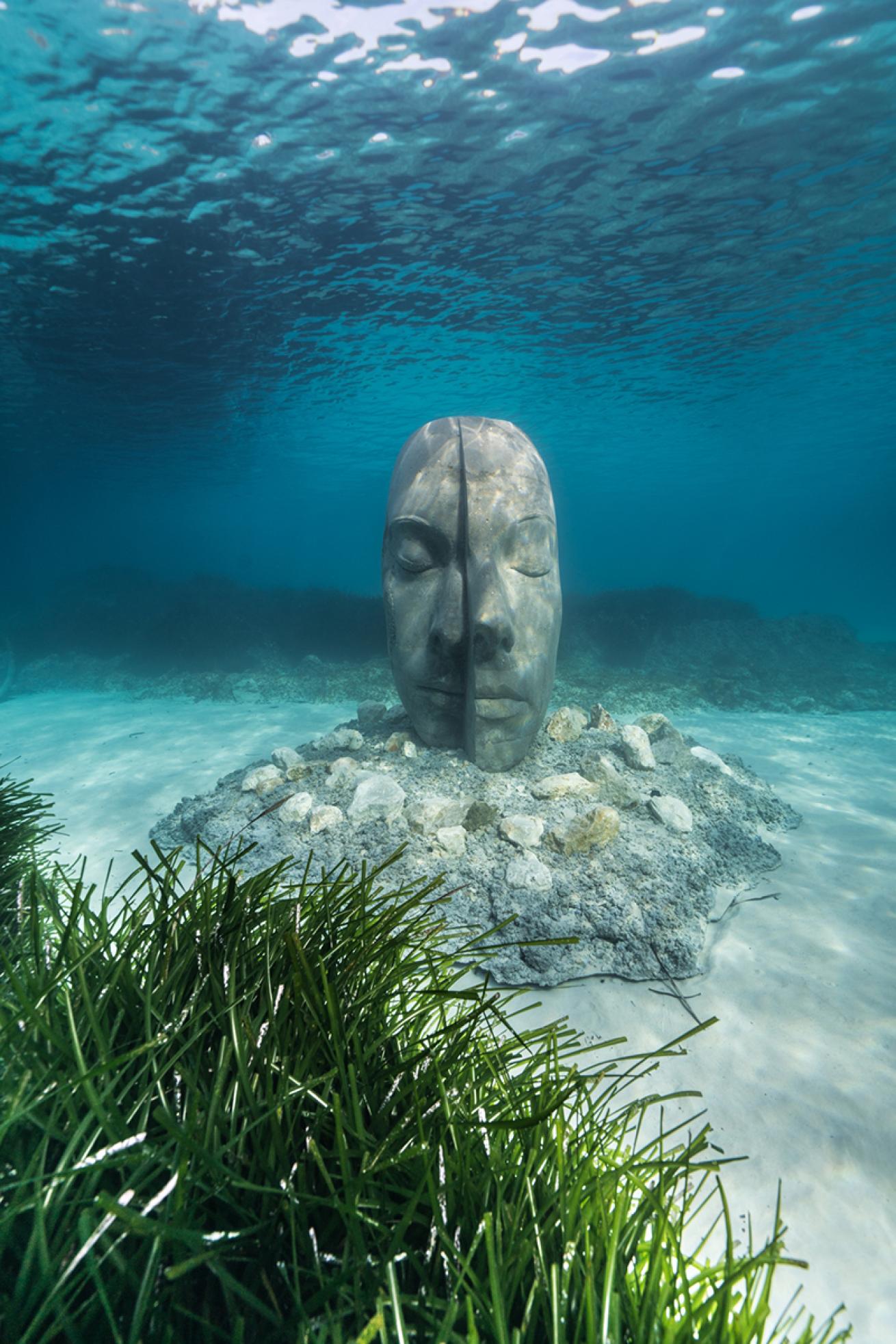Are Artificial Reef Exhibits a New Era in Scuba Diving?

Courtesy ReefLineA spiral coral staircase designed by Japanese architect Shohei Shigematsu will be one of the first installations in Miami's upcoming ReefLine.
Let’s face it: One of the main reasons why we put on a wetsuit and tank to go scuba diving is to see what we can find underwater. Beyond the obvious (fish, coral reefs and ocean caves), some of us secretly wish to find an underwater gem, like an abandoned airplane or maybe a shipwreck.
Now we can find even more, thanks to artists, scientists and curators creating underwater exhibits stuffed with staircases, cars, human-like figures and even military tanks. These marine exhibits are popping up from Miami to Townsville to Cannes, launching a new era of scuba culture.
In Miami, the ReefLine, a seven-mile sculpture park running along Miami Beach just north of PortMiami at about 20-feet, will partially launch in winter 2021. Founded by Argentinian curator Ximena Caminos, it will be more than just eye candy — it will double as an artificial reef, providing habitat for endangered organisms, strengthening coastal resilience and boosting biodiversity. Leandro Erlich, who created a sand sculpture of a “traffic jam” for Miami Art Week 2019, will be making a permanent version for the submerged collection, and Japanese architect Shohei Shigematsu has designed a spiral, stair-like structure to house a new coral reef.
“This series of artist-designed and scientist-informed artificial reefs will demonstrate to the world how tourism, artistic expression and the creation of a critical habitat can be aligned,” says Caminos. “The ReefLine is a singular investment in civic infrastructure, public art and environmental protection that will pay dividends over the coming decades and attract ecologically-minded tourists and art lovers.”
A multidisciplinary coalition is backing the daring installation, speaking to underwater art’s growing appeal. The team includes Camino’s BlueLab Preservation Society, the city of Miami, its tourism board, private foundations, a coral reef media company, state artificial reef grants, local hotels and private philanthropists. Scientists from the University of Miami, Harvard University and other institutions will research the sites to study artificial reef development.
“The ReefLine is a unique project that brings attention to and mitigates the dangers of climate change in Miami Beach, while enriching the city's vivid art scene" says Shigematsu. “We look forward to collaborating with a diverse group of experts and professionals on our first underwater cultural masterplan and sculpture.”
Not everyone is convinced. In the Dominican Republic, Charles Beeker, director of Indiana University’s Center for Underwater Science, is one of underwater art’s skeptics. He has created several underwater exhibits that emphasize “in situ preservation,” such as an 18th century Spanish wreck known as the Living Museum in the Sea. He feels there is a difference between authentic underwater discoveries that share history and archaeology with the diving public and crafted sites.
“I believe in authentic objects being placed as exhibits, but adamantly opposed to so called artworks placed underwater,” he says “Reef balls for habitats and barriers for beach erosion [are] not artwork sculptures placed underwater.”
Despite critics, the trend is growing worldwide. Across the pond, Europe’s first underwater museum, Museo Atlantico, opened off the coast of Spain in 2016. And divers headed to the Middle East will find plenty of underwater art exhibitions. Dive Bahrain, which claims to be the “world’s largest underwater theme park,” officially opened in September 2019. It’s here divers get to see a Boeing 747 aircraft that sank and is being used as an artificial reef, while the guided tour includes sail structures and ships. Off the coast of Aqaba, Jordan in the Red Sea, the world's first Underwater Military Museum offers a diving trail of 19 battle vehicles.

Courtesy Underwater Military MuseumA purpose-sunk tank is one of the exhibits divers can explore in the Red Sea's Underwater Military Museum.
Jason deCaires Taylor, arguably the biggest name in underwater artwork, has been on the rise in recent years. His new The Museum of Underwater Art, 20 statues of human figures called “reef guardians” and made of pH neutral cement, opened in the summer of 2020. The first of its kind in the southern hemisphere, the art highlights the Great Barrier Reef in Townsville, Australia.
This example of deCaires Taylor’s “environmentally aware tourism” is expected to generate over $32 million (USD) in economic activity annually, bringing roughly more than 50,000 visitors to the region every year and creating nearly 200 jobs.
In this project, like so many others, the artist puts the environmental crisis at the heart of his work. In one underwater sculpture, a child holds a plant growing in its infancy, while another shows a man digging in the ground outside of a “Coral Greenhouse.” “These young people standing inside and outside of the greenhouse are involved in horticultural and scientific activities,” said the artist. “It’s intended to symbolize hope.”
Some other figures are modeled after Townsville locals, many of who are members of a disappearing First Nations community.

Matt CurnockA figure sculpted after a First Nations man living near Townsville, Australia digs sand in deCaires Taylor’s Museum of Underwater Art.
Art aside, deCaires Taylor says it's more important how these exhibits help the ecosystem. Over the past few decades, he says, we have lost over 40 percent of our natural coral reefs, and scientists predict we will lose 80 percent of them by 2050.
“Our vision is to create a global art attraction which tells the stories of the land, people and environment; provides significant economic benefit to the local economy and builds the capacity of operators and businesses within the local tourism industry,” he says. Now, the artist is launching a new underwater project in Cannes, France. “It’s the first time I’m working in the Mediterranean. I think many people, when they imagine the ocean, think of tropical reefs and large pelagic species, whereas I have found some the Posidonia meadows to be some of the most mysterious and beautiful seascapes I have encountered.”

Courtesy Jason deCaires TaylorA split face sculpted by Jason deCaires Taylor rests on the Mediterranean seabed.
His new exhibition features various sculptures, including a giant human face divided in half, depicting two different expressions. Another shows a woman throwing her arms up in freedom. They’re portraits of locals in Cannes, which the artist made masks of. Six works are on view, from a 9-year-old child to an 80-year-old fisherman. This project was a commission of the Mayor of Cannes, David Lisnard, and is funded by the local government. It took over four years to develop.
With more projects to come and a growing demand for innovative marine experiences, deCaires Taylor does not see underwater art exhibitions going to stop anytime soon.
“I am glad to see the trend for underwater art increase,” he says. “We live on a blue planet, which from an artistic point of view, has barely been explored. I also think underwater museums can be a great way to help manage tourists and minimize impacts on the fragile natural sites whilst raising revenue to support local marine parks.”
He adds: “I also realize that no man-made object can compete with the beauty of the natural world, it can only remind viewers of our dependence on it and how a symbiotic relationship can be possible.”
Related
- Divers Reinvent Wreck Diving in the British Virgin Islands with Pirates and Shark-Planeo
- Artists to Follow on Instagram if You Care About Ocean Conservation
- Ocean-Themed Murals Spread Conservation Message










